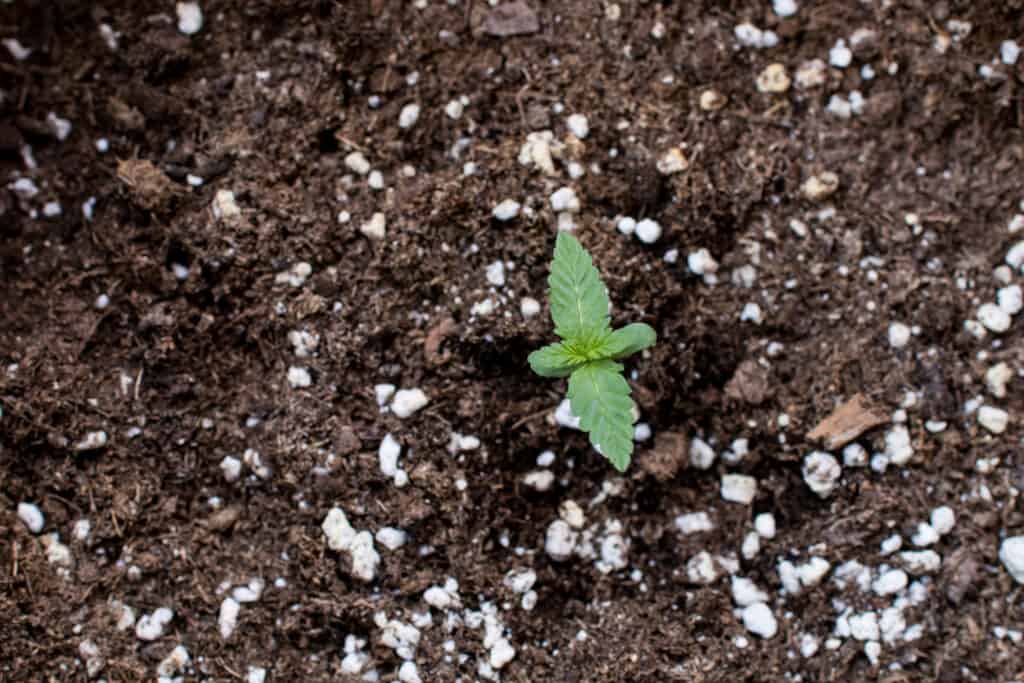TABLE OF CONTENTS
In addition to deciding on the strain genetics, lighting, and nutrients to use, cultivators must choose the most appropriate grow medium—as well as whether the garden will be hydroponic, aeroponic, DWC, or soil-grown.
This article will address two of the lesser-used grow medias: coco coir and perlite.
Soil-based gardens can utilize a wide variety of ingredients for various soil mixes, including basic potting soil, coarse sand, sphagnum moss, wood chips, coco coir, perlite, fine gravel, and compost.
As long as the grow medium has good aeration and drainage, cannabis plant roots can grow healthy and strong.
Combining perlite and coco coir as the only two ingredients in a potting mixture can yield excellent results. However, its use together is somewhat unconventional compared to more mainstream practices that utilize soil in the mix.
Here, we will show you the pros and cons of coco coir and perlite and how to make your own soil mix.
Perlite
Perlite is heat-treated volcanic ash derived from obsidian. To create the form used in cannabis cultivation, it’s mined and then heated at very high temperatures in a specific manner and treated so that it assumes the small, lightweightgranular form that has a Styrofoam appearance and consistency.
Perlite is generally available in three grades: fine, medium, and coarse. Cannabis growers usually use the fine-grade perlite in their grow mixture to improve the drainage of the medium.
Perlite is a popular grow medium for use in both hydroponic and soil grows. The absence of conventional potting soil makes the mix less dense, with lots of aeration, promoting the development of cannabis root systems.
Many cultivation mixes utilize either perlite or vermiculite, and both work well. Both are a common ingredient in mixes, and each accomplishes the same purpose—aeration—so rarely will you see both used together.
Perlite Features
Perlite has some unique features that make it beneficial for both outdoor and indoor horticulture.
It’s very lightweight—much like coco coir—so plant pots or bags will have much less weight when filled, which are easier to transport.
Because of its lightweight, porous structure, perlite absorbs water like a sponge and retains it well, promoting water retention and aeration, which will prevent stagnation of dense soils and nutrient buildup.
It also has a neutral pH level. Perlite pH typically falls in the 6.5 to 7.5 range—which is the perfect level for growing high-quality cannabis.Since pH is neutral, it will not affect the water’s pH or EC.
When used with soil, perlite breaks up soil density and makes the mix less compact. It helps the soil retain water and provides vital aeration. Giving your roots more oxygen promotes faster growth.
Although a great way to grow cannabis, soil can become very compact, especially after repeated watering, which makes the soil settle and increases the risk of overwatering. Perlite is valuable for breaking up the dense consistency of settled soils and allows cannabis to grow unrestricted beneath the soil surface. Also, because it promotes a less-dense consistency to cultivation media, it encourages faster water absorption and runoff.
Perlite is organic and stable, so there is no risk of introducing harmful fungi or bacteria into a garden when using it. It will not decompose or break down to be a source of harmful pathogens.
All of these benefits make it a great material for use with clones. A clone’s new roots can easily work their way through the lightweight structure of the grow medium with perlite, which is especially helpful if the roots are growing fast.
You can make your own perlite mix or buy prepared grow mediums that have perlite added to the mix. Generally, cannabis growers add between 10 and 50% perlite to the grow mix. For plants that use only a small concentration of nutrients and additives, 20% perlite mix is good. For plants that use a lot of nutrients, 50% perlite in the mix can improve drainage and help prevent nutrient buildup and lockout.
Coco Coir
Coco coir (pronounced “coy-er”) is a recycled, organic material that comes from the husk of coconuts. This coarse, fibrous material is an excellent medium for growing cannabis plants.
Coco coir is primarily grown in Sri Lanka and India. Since they have a similar consistency, many pre-made soil mixes contain either peat moss or coco coir, but coco coir can be sold separately in blocks, chips, or bags with loose material such as FoxFarm Coco Loco potting mix.
Both materials can work well and have their own unique benefits and drawbacks. Most cannabis cultivators have a preference for one or the other, with more of them opting for coco rather than sphagnum and peat moss.
Although similar to peat moss in its consistency, coco coir has its own unique set of benefits, which differentiates one from the other.
One of the benefits of coco coir is that its pH typically runs 6.0 to 6.7, which is within the ideal range for cannabis—and very similar to the pH of perlite.
Since coco coir is harvested from coconuts, it’s a renewable resource—unlike peat moss. Generally, peat moss is unsustainable. It comes from bogs and grows very slowly. Harvesting peat moss negatively affects the ecosystem that thrives in this environment.
In addition, coco coir does not have to be replaced as often as peat moss. Peat moss breaks down quicker than coco coir. Coco coir can be used multiple times if it is properly rinsed.
Coco coir also absorbs water better and is easier to rehydrate if it becomes overly dry. It has excellent water-retention properties, retaining eight to 30 times its own weight. Like peat moss, coco coir is an outstanding habitat for microorganisms and is free of pests, pathogens, and weed seeds.
Coco coir is also durable and due to its lignin content, it breaks down slower than peat moss. Finally, coco coir is typically less expensive than peat moss—and this lower cost is something that everyone can appreciate.

Coco Coir Drawbacks
Coco coir also has some drawbacks. It has a high salinity unless thoroughly washed, and its quality and consistency can vary more than peat moss, depending on the source. It also doesn’t contain many microorganisms and few trace elements.
Since it is an inert grow medium, it does not have any nutrients, so growers must provide their plants with nutrients and maintain their pH levels throughout the plant’s life cycle.
Also, because some coco coir is sprayed with pesticides in its country of origin, combined with its tendency to be high in sodium and magnesium, means that it must be thoroughly washed and treated (follow the same instructions for treating coco coir as the peat moss method detailed above).
In addition, plants grown in a coco coir mix usually require a calcium and magnesium supplement. A basic Cal-Mag supplement such as CaliMagic by General Hydroponics or Botanicare are popular choices among cannabis growers. Generally, growers use the same brand of supplements and nutrients for compatibility.
While pre-made coco coir mixes are easy to use, they can be more expensive than coir bricks. Pre-made mixes are heavier because the mix has been hydrated with water, increasing the shipping costs. Coir bricks are more affordable but require re-hydration. However, re-hydrating the bricks is easy.
Because peat moss and coco coir have several similarities and differences, it’s easy to see why both are popular. There are really no right or wrong answers when it comes to using one or the other; it’s just a matter of personal preference. Some popular soil mixes on the market include both.
Since it’s used less often than coco coir for cannabis cultivation and has many benefits, do not overlook peat moss the next time you plan a cannabis soil mixture. Most likely, you will be happy with the results and use it as a regular soil ingredient.
Creating a Perfect Coco Coir and Perlite Mix
Because both coco coir and perlite are low in density, the combination of both materials will promote rapid, unrestricted root growth as well as rapid runoff, while still retaining beneficial moisture levels in the grow medium.
While both materials work in similar ways, the consistency and shape of each is quite different, which makes their use together fairly popular and efficient for any type of grow system.
Let’s discuss the creation of two basic cultivation media that are similar and extremely easy to create using coco coir and perlite. Both contain coco coir and perlite, but one mix has just these two ingredients, and the other includes another valuable ingredient: compost.
Coco Coir and Perlite Mixture
The first is just a basic coco coir and perlite mixture. The mix should contain more coco than perlite, at a 60/40 or 70/30 ratio of coco/perlite. This combination will make a good medium for transplanting young cannabis plants started in soil into their permanent mix.
Include the soil when transplanting the seedling into its new pot. The well-aerated coco/perlite will provide an excellent way for the root systems to grow in an unrestricted manner. The mix will likely settle. Simply adding more coco/perlite or some compost will help maintain sound, organic growing practices.
For top-feed systems or ebb and flow hydroponic setups, loose coco coir with perlite is recommended. For deep water culture (DWC) systems, coco chips are good to use.
Pre-made coco and perlite mixes are easy to use, especially for beginners that do not want to rehydrate coco bricks. Mother Earth Coco and Perlite Mix contains 70% coco pith and fiber and 30% perlite for ultimate aeration and drainage.
You can also go with Roots Organics Coco Soilless Mix containing a roughly 60/40 perlite/coco mix. This mix also includes trace amounts of bat guano for microbial support, but is generally considered an inert media.
Coco Coir, Perlite, and Compost Mixture
The second mix has one more ingredient apart from the coco coir and perlite and is nearly as easy to make. The recipe is simple and includes equal parts of compost, coco coir, and perlite.
You can either make your own compost or buy it bagged at a nursery or grow store for an easier set up. Thoroughly mix the three ingredients together, and plant or transplant your plant directly into the mix.
Either of these mixes results in thriving cannabis plants, if they are maintained correctly. Both mixes will require organic soil amendments, since they do not contain a significant nutrient content.
Good organic amendments include kelp meal, bat guano, alfalfa meal, fish emulsion, bone meal, manure, blood meal, rock phosphorus, and earthworm castings. These amendments are rich in nitrogen, phosphorus, and potassium, the main macronutrients needed in certain stages of the life cycle.
Both of these soil mixes will provide good results in pots that allow easy and rapid runoff. Air Pots® work very well for either of them. Because both coco coir and perlite, as well as Air Pots, promote rapid runoff and aeration, there will be a stronger, more frequent need to water and feed the plants, especially during their most vigorous stages of growth.
If you’ve mainly used more traditional grow media, coco coir and perlite are well worth trying. When used correctly, they provide an excellent way to grow outstanding organic cannabis.
Growing Cannabis in Coco Coir Perlite Mix FAQ's
What is Coco Coir and Perlite mix, and why is it good for growing cannabis?
Coco Coir is a natural fiber that is collected from the husks of coconuts, and perlite is a volcanic glass that helps promote the aeration of soil particles. Because of its high capacity for water retention and drainage, its neutral pH, and its ability to encourage the formation of robust roots, this mixture is a good choice for the cultivation of cannabis.
How do I prepare a Coco Coir and Perlite mix for cannabis cultivation?
Blend together coco coir and perlite in a proportion of approximately 70:30. If the coco coir is in a compressed condition, it should be expanded and rinsed before it is used. This will remove any salts that may be present. The aeration and drainage of the mixture will be improved as a result of the perlite.
Does cannabis grown in Coco Coir and Perlite require specific nutrients?
Yes, because coco coir is inert and does not contain any nutrients, you will need to give a comprehensive hydroponic nutrition solution that is ideal for cannabis that contains both macronutrients and micronutrients.
How often should I water cannabis in a Coco Coir and Perlite mix?
While the frequency of watering should vary based on the stage of growth, in general, you should water more regularly than you would with soil. Coco coir has a high capacity for water retention; therefore, it should be kept continually moist without becoming waterlogged.
Can I reuse Coco Coir and Perlite mix for growing cannabis?
Yes, it is possible to reuse it after giving it a thorough rinse to get rid of any old roots and to supply it with fresh nutrients. However, many growers prefer to use fresh mix for each new cycle because it enables them to achieve the best possible results and prevents the accumulation of diseases.
Is pH adjustment necessary when growing cannabis in Coco Coir and Perlite?
Altering and keeping an eye on the pH of your nutrient solution is, without a doubt, quite significant. For cannabis grown with coco coir, the pH range that is considered to be optimal is often between 5.5 and 6.5.
“
There are over 300,000 jobs in the cannabis industry. CTU trained me for one of them!

Makes $24.50 @ THC +
How does the Coco Coir and Perlite mix affect the growth speed and yield of cannabis?
As a result of improved root oxygenation and increased nutrient uptake, this mixture has the potential to result in increased growth rates. Additionally, it has the potential to result in larger yields as compared to conventional soil grows if it is managed correctly.
Do I need to add beneficial microbes to the Coco Coir and Perlite mix?
Although it is not required, the addition of helpful bacteria can increase the root health and the plant's ability to absorb nutrients. In the world of cannabis cultivation, Mycorrhizae and Trichoderma are two of the most preferred options.
Is the Coco Coir and Perlite mix suitable for both indoor and outdoor cannabis cultivation?
There is no doubt that this mixture is adaptable and may be utilized for cultivation in either an indoor or outdoor setting. However, in order to keep the growing circumstances at their optimal level, environmental elements such as temperature and humidity should be taken into consideration.
Learn to Grow Marijuana Like the Pros
Gain a complete understanding of the cannabis industry by enrolling in Cannabis Training University (CTU) today!
CTU is the most renowned cannabis school in the world. Whether you’re a first-time user, a beginner grower, or an entrepreneur looking for a new adventure, CTU’s online industry training program makes it affordable and easy to become a Master of Marijuana.
Our cannabis curriculum covers the most important aspects of the industry including:
- Cannabis cultivation
- Cannabis medicine
- Cannabis cooking
- Cannabis extraction
- Cannabis laws
- Cannabis careers
- Cannabis business
In our cannabis cultivation course, students of all skill levels can learn the essentials of growing cannabis from seed or clone. Our cultivation course takes you through every stage of the cultivation process from planting to harvesting, drying, and curing.
No matter your budget, our curriculum offers affordable recommendations for your entire garden set-up, including lighting, nutrients, containers, and so much more.
Top growers in the industry give you pro tips on creating your soil mix and using coco coir and perlite, the right way. Start to learn to grow weed today.

Luis Cordova
Luis Cordova is a distinguished author, and renowned expert in cannabis cultivation, who possesses a Master's degree in Plant Biotechnology and Pharmaceutical Science. As a valued contributor to highly esteemed publications such as Cannabis Training University and Maximum Yield Magazine, Luis has emerged as a trusted source of guidance and knowledge in the cannabis industry. Having written thousands of informative articles, Luis is widely recognized for his comprehensive expertise on cultivating cannabis, both indoors and outdoors.












 Jeff was involved in an accident where he endured a traumatic brain injury. He had a week-long stay in ICU where brain surgeons
Jeff was involved in an accident where he endured a traumatic brain injury. He had a week-long stay in ICU where brain surgeons  100% risk free money back guarantee within 48 hours after purchase if student has not completed any of the courses or exams.
100% risk free money back guarantee within 48 hours after purchase if student has not completed any of the courses or exams.